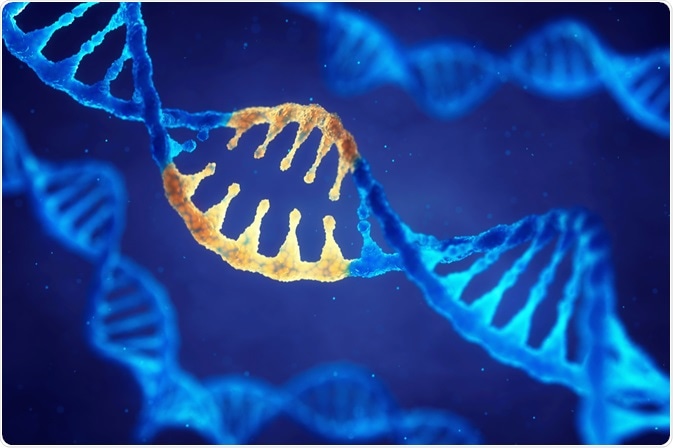Cystinuria is an inherited genetic condition that involves changes in the extent of reabsorption of cystine and other dibasic acids from the urine and into the bloodstream. As a result, affected individuals are at a higher risk of developing calculi in the kidneys, known as kidney stones.

Image Credit: nobeastsofierce / Shutterstock
Inheritance Pattern
Cystinuria follows an autosomal recessive inheritance pattern. This means that an individual needs to inherit one gene mutation for the condition from each parent in order to be affected.
If both parents are carriers of the gene mutation for cystinuria, each child will have a 25% chance of suffering from the condition, a 50% chance of being a carrier for the condition and a 25% chance of being unaffected.
Related Genes
There are many genes that are associated with cystinuria, the most notable of which are SLC3A1 and SLC7A9. These genes play a role in the production of the subunits of a protein complex that exists in the kidneys, which helps to regulate the reabsorption of cystine and other amino acids into the blood from the urine.
Mutations in the SLC3A1 of the SLC7A9 gene can change the activity of the protein complex and lead to less reabsorption of cystine and hence high concentrations of the amino acid are excreted in the urine. This can result in the formation of crystals and the characteristic symptoms of cystinuria.
SLC3A1 Gene Mutation
The SLC3A1 gene was first associated with the uptake of cystine and dibasic amino acids in 1992, originally known as the rBAT gene, and exists on chromosome 2. It was discovered shortly afterward that it plays a role in the proximal tubule and small intestine in the body.
The M467T mutation is particularly common in this gene and is most likely to affect individuals with Mediterranean origins. For example, the mutation accounts for almost half of patients in Spain but is rare in other regions of the world.
SLC7A9 Gene Mutation
The SLC7A9 gene was isolated in 1999 and found to encode an amino acid membrane protein, known as BAT1, on chromosome 19.
Similar to the SLC3A1 gene, a mutation in the SLC7A9 gene is more common in particular population groups, specifically Libyan Jews. Individuals that inherited a gene mutation in this locus from both parents are at a greater risk of suffering from urolithiasis.
Genetic Classification
There have been several attempts to classify the genetic characteristics of cystinuria into distinctive types. Type I, Type II and Type III cystinuria initially were developed to identify the involvement of specific genes in the pathology of the condition. A more recent classification system is as follows:
- Type A: mutation in both SLC3A1 alleles, with normal cystine and dibasic amino acid excretion in the urine.
- Type B: mutation in both SLC7A9 alleles, with increased cystine and dibasic amino acid excreted in the urine.
- Type AB: mutation in one SLC3A1 and one SLC7A9 allele, also known as mixed-type cystinuria.
These classifications are designed to help patients and practitioners recognize defining characteristics of the disease, which may affect the management plan of the condition.
References
Further Reading
Last Updated: Feb 24, 2021